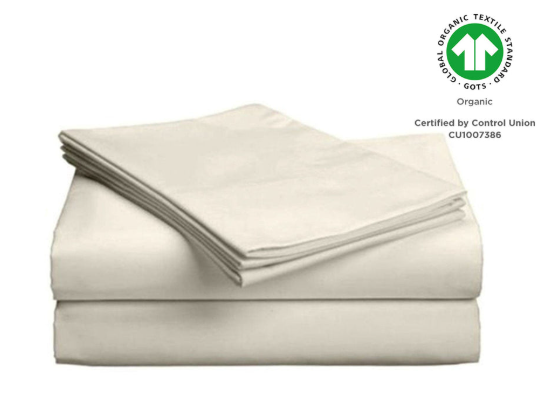Shopping for high-end sheets can feel overwhelming. With countless brands touting luxury, it’s easy to assume that a higher price automatically means better quality.
Yet, some sheets command a premium more for their name than their craftsmanship. Truly luxurious sheets go beyond the marketing—they offer a blend of comfort, durability, and thoughtful design that makes bedtime feel like a retreat.
Understanding how to separate genuinely expensive sheets from overpriced ones is essential for a smart purchase.
By learning what to look for, choosing bedding that lives up to its price becomes easier, ensuring that every night’s sleep is as restful and luxurious as promised.
1. Fabric Quality: Thread Count vs. Fiber Type
Why it matters:
Too often, people fixate on thread count—“300, 600, 800!”—as if higher always equals softer.
But here’s the thing: a blanket of cheap cotton fibers can be woven tight to hit high thread counts, and it won’t feel luxurious. What matters is the type of fiber—long-staple cotton like Egyptian or Pima, or natural fibers like linen or bamboo silk.
What to look for:
- Long-staple cotton has longer, stronger, and smoother fibers, making soft and durable sheets.
- Egyptian or Supima® cotton often charges a premium, but the feel and longevity can justify it.
Linen, especially European flax, may feel rough initially, but a few washes will reveal softness and breathability, perfect for hot sleepers. - Bamboo or eucalyptus-derived rayon offers a silky touch and moisture-wicking, but check for sustainability certifications.
How to test it:
If you can, feel the fabric before buying. Notice how dense or airy it feels between your fingers. Cheaper cotton can feel papery or plasticky, even at higher thread counts. Truly expensive sheets feel smoother and more inviting immediately.
2. Weave and Construction: More Than Just a Pretty Texture
Why it matters:
A sheet can feel crisp or silky depending on how its yarns cross. That interlacing decides whether the set will fray after a few washes or shrug off laundry day like nothing happened.
Common weaves:
- Percale feels crisp, cool, and breathable like a fresh hotel sheet.
- Sateen has a glossy finish and silky feel, but can pill and age faster if poorly made.
Twill and jacquard weaves introduce texture, but can trap heat if too heavy.
Look beyond the gloss:
High-end sateen shouldn’t feel flimsy. Percale is special because, even though the weave is tight, air shuffles in and out. Good work shows in the seams; one glance there will reveal if stray threads huddle or if the surface ripples unevenly. Press the cloth with a fingertip; a decent percale pushes back and feels sturdy, not flimsy like a napkin.
3. Durability Indicators: Seams, Stitching, and Maintenance
Why it matters:
You want sheets that wear well, stay smooth after a hundred washes, and don’t look ragged after a year. A high price tag doesn’t guarantee that.
Things to check:
- Stitching quality: seams on high-quality sheets have tight, even stitches. Loose threads, skipped stitches, or fraying edges are red flags.
- Colors and dyes: Truly well-made sheets use colorfast dyes—wash them, and the color stays strong. If your sheets fade unevenly after a few washes, that’s usually a sign of less expensive production.
- Shrinkage rates: Natural fibers shrink slightly during the first wash, which is fine. But anything over 5% is sloppy and may signal “expensive” but not high quality.
Little tangent—washing tip:
A quick note: air-drying sheets preserve fibers better than high-heat dryer cycles. If a brand includes care instructions like “low tumble dry” or “line dry gently,” it often indicates they care about longevity, not just your first impression.
4. Certifications and Transparency: Trust, Not Just Hype
Why it matters:
People who wander through high-end boutiques these days usually look past the polish and glare of a fresh display. They want to know how a product was made, whether the people involved were treated fairly, and whether what they buy will mess with their bodies later.
Labels that really care and can prove they don’t settle for a pretty story flash certifications and publish supply-chain maps to keep the conversation honest.
Meaningful certifications include:
- OEKO-TEX® Standard 100: ensures textiles are free from harmful substances.
- GOTS (Global Organic Textile Standard): covers organic fibers through ethical labor and eco-friendly processes.
- Better Cotton Initiative (BCI) or Fair Trade: offers some social and environmental responsibility assurance.
Pull it back together:
These labels matter because truly expensive sheets often carry an environmental or health cost; certifications show a commitment beyond the label, and you’re more likely to get quality that lasts if a brand invests in responsible sourcing.
5. Sleep Experience: Comfort, Feel, and Value Over Time
Why it matters:
The true value of sheets is in how they make you feel—every night, every morning, through seasons and phases of life.
How to sense authenticity:
- Ask if the brand offers a trial period or warranty—softness should last after a few washes, not vanish.
- Read customer feedback: Do reviewers mention comfort and longevity, or are they mostly about “it looked fancy”?
- Notice subtle differences: some sheets mold to your body over months, are breezy but insulating, and maintain a certain “character.” Over time, these develop personal value.
Final Thoughts
It’s easy to be seduced by marketing language like “plush forever” or “ultimate indulgence.” But lean on your senses: touch the fabric, inspect stitching, check certifications, and most importantly, think about how the sheets feel night after night.
That’s when you realize—some sheet sets earn their price, while others don’t.
Buying truly luxurious sheets is a small act of self-care. It’s a quiet investment in comfort, sustainability, and enjoyment. By following these five key ways, you’ll become a savvy shopper who knows that true luxury whispers, it doesn’t scream.
Sleep well—and may your sheets always be worth every penny.

